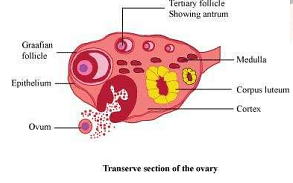Draw a labeled diagram of a section through ovary.
Solution and Explanation

Top Questions on Human Reproduction
- Name any two VDs which might occur in a human female. State any two complications in a female if it is left untreated.
- CBSE CLASS XII - 2025
- Biology
- Human Reproduction
- Student to attempt either option (A) or (B):
(A) (i) Explain why the milk produced by the mother during the initial days of lactation is considered to be very essential for the newborn infant.
(ii) What is the term used for the milk produced during the initial days of lactation?
OR
(B) Many children in the metro cities are suffering from a very common exaggerated response of the immune system to certain weak antigens in air.
(i) What is the term used for the above mentioned disease?
(ii) Name the main type of antibody produced by the immune system in response to this disease.
(iii) Which two main inflammation-causing chemicals are produced by the mast cells in such an immune response?- CBSE CLASS XII - 2025
- Biology
- Human Reproduction
- The first menstruation is called:
- NEET (UG) - 2025
- Biology
- Human Reproduction
- Consider the following:
A. The reductive division for human female gametogenesis starts earlier than that of male gametogenesis.
B. The gap between the first meiotic division and the second meiotic division is much shorter for males compared to females.
C. The first polar body is associated with the formation of the primary oocyte.
D. Luteinizing Hormone (LH) surge leads to disintegration of the endometrium and onset of menstrual bleeding.- NEET (UG) - 2025
- Biology
- Human Reproduction
- Assertion (A): Cu-T, Cu-7 and LNG-20 are the most widely used copper-releasing IUDs.
Reason (R): Cu-ions in IUDs effectively suppress sperm motility and the fertilising capacity of sperms.- CBSE CLASS XII - 2025
- Biology
- Human Reproduction
Questions Asked in CBSE CLASS XII exam
- A parallel plate capacitor with plate area \( A \) and plate separation \( d \) has a capacitance \( C_0 \). A slab of dielectric constant \( K \) having area \( A \) and thickness \( \left(\frac{d}{4}\right) \) is inserted in the capacitor, parallel to the plates. Find the new value of its capacitance.
- CBSE CLASS XII - 2025
- capacitor with a dielectric
- You are Kirti / Keshav of 7, M.G. Road, Jhansi. You are disturbed by students littering parks during one-day picnics. Write a letter to the editor of a national daily suggesting ways to inculcate civic sense among students. Use the given cues to draft the letter.
- CBSE CLASS XII - 2025
- Writing Skills
- Your school is organising an inter-house ‘Maths Quiz’ Competition. As president of the Quiz Club, draft a notice informing students of Classes IX – XII about the competition. Include necessary details regarding the number of participants, registration date, etc. You are Akila / Akhil. Put your notice in a box.
- CBSE CLASS XII - 2025
- Writing Skills
Study the given molecular structure of double-stranded polynucleotide chain of DNA and answer the questions that follow.

(a) How many phosphodiester bonds are present in the given double-stranded polynucleotide chain?
(b) How many base pairs are there in each helical turn of double helix structure of DNA? Also write the distance between a base pair in a helix.
(c) In addition to H-bonds, what confers additional stability to the helical structure of DNA?- CBSE CLASS XII - 2025
- Molecular Basis of Inheritance
- Find the absolute maximum and absolute minimum of the function \( f(x) = 2x^3 - 15x^2 + 36x + 1 \) on \( [1, 5] \).
- CBSE CLASS XII - 2025
- Absolute maxima and Absolute minima
Concepts Used:
Female Reproductive System
The female reproductive system provides various functions. The ovaries produce the egg cells known as the ova or oocytes. The oocytes are then taken to the fallopian tube where fertilization by a sperm may occur. The fertilized egg is then transferred to the uterus, where the uterine lining has thickened in regard to the normal hormones of the reproductive cycle. Once in the uterus, the fertilized egg can implant into the thickened uterine lining and continues to develop. If implantation does not take place, the uterine lining is shed as menstrual flow. In addition, the female reproductive system produces female sex hormones that preserve the reproductive cycle.
During menopause, the female reproductive system slowly stops making the female hormones that are required for the reproductive cycle work. At this stage, menstrual cycles can become irregular and finally stops. One year after menstrual cycles pause, the woman is deemed to be menopausal.